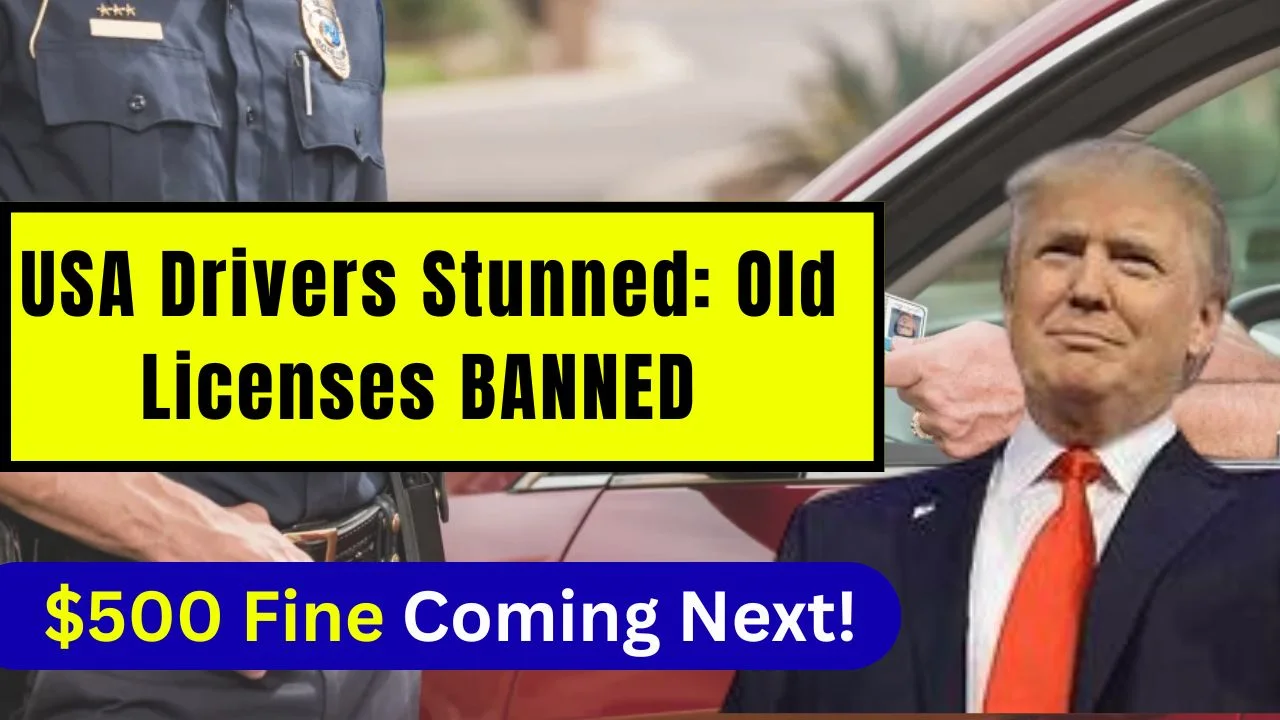Millions of drivers are alarmed after hearing about an upcoming Old License Ban USA, with many worried they could soon face $500 fines simply for using their current driver’s license. Stories are spreading online, sparking panic and confusion. The topic is trending because of overlapping issues: the federal REAL ID deadline, new state rules restricting certain types of licenses, and higher penalties for violations. This mix has created an impression of an outright ban on old licenses when, in reality, the situation is more nuanced.
In this article, we will unpack everything you need to know about the Old License Ban USA, from the REAL ID requirements to state-level restrictions and fines. By the end, you will understand what is real, what is exaggerated, and how to stay on the right side of the law as these changes roll out in 2025.
Old License Ban USA: What It Really Means
The phrase Old License Ban USA has captured national attention, but it is misleading. The federal government is not banning old licenses for driving. Instead, after May 7, 2025, non-REAL ID licenses will no longer be valid for federal purposes like boarding domestic flights or entering secure government facilities. At the same time, certain states, including Florida and Tennessee, have introduced rules refusing to honor “drive-only” licenses from other states, which are typically issued to undocumented or temporary residents. Violations of these rules may result in fines up to $500. These overlapping changes have fueled public misunderstanding about what is actually happening.
It’s important for drivers to check both federal and state-specific ID requirements to avoid complications. While standard licenses remain valid for driving within your home state, using them for air travel or in certain legal situations may no longer be accepted. Staying updated can help prevent delays, fines, or denied access during travel.
Overview of Key License and ID Changes
| Key Topic | Details |
| REAL ID Deadline | Enforcement begins May 7, 2025 for federal purposes like boarding planes |
| License Validity | Non-REAL ID licenses still valid for in-state driving |
| State Restrictions | Florida, Tennessee ban recognition of certain “drive-only” licenses |
| Fines | Up to $500 for restricted license use or traffic violations |
| REAL ID Appearance | Marked with a star in the top-right corner of the license |
| Traffic Law Changes | New $500 fines for reckless driving and speeding 30 mph over the limit |
| Impact on Travelers | REAL ID required for flights or federal building access after May 2025 |
| Public Awareness | Still low; campaigns underway to inform drivers |
| Digital Driver’s Licenses | Being piloted in states like Arizona and Colorado |
| State-by-State Differences | Rules vary, check local DMV for specific updates |
REAL ID and the Federal Deadline
The REAL ID Act was passed in 2005 to strengthen security and identity verification after 9/11. Its enforcement date has been delayed several times, but May 7, 2025 is now the final deadline. From that date, a REAL ID or another approved ID such as a passport will be required for domestic flights and entry into federal facilities. Licenses without the REAL ID star will not meet federal standards but will remain valid for driving within your state. This is not a ban on your ability to drive, but it does mean your ID may be rejected at airports and secure buildings. Travelers are encouraged to check their current licenses and upgrade to a REAL ID well before the deadline to avoid last-minute complications. State DMV websites offer information on required documents and appointment availability.
State-Level Restrictions on Marked Licenses
Alongside the federal deadline, some states have created their own policies. Florida and Tennessee no longer recognize “drive-only” licenses issued by other states. These licenses are usually for undocumented immigrants or temporary residents. Lawmakers say the restrictions are meant to prevent fraud, while critics argue they punish people who rely on limited IDs for daily activities. Using a restricted license where it is not accepted can result in fines as high as $500 and, in some cases, even jail time. This has added to the public’s confusion over an “old license ban” that does not actually exist at the federal level.
Traffic Violations and Higher Fines
Another reason drivers believe their old licenses might lead to fines is the rise in penalties for dangerous driving. In Florida, House Bill 351, passed in July 2024, introduced $500 fines for drivers caught exceeding the speed limit by 30 miles per hour or more. Georgia and Virginia have similar “super speeder” laws. These penalties target reckless driving behavior and have nothing to do with license expiration or federal compliance. However, because these new fines are being introduced at the same time as the REAL ID deadline, many people think the two are linked.
Impact on Travelers and Workers
The most visible impact of the REAL ID deadline will occur at airports. Beginning in May 2025, travelers without a REAL ID or another accepted form of ID will be denied boarding on domestic flights. Federal workers, contractors, and visitors will also need a compliant ID to enter government buildings. Airlines expect delays and confusion as the deadline approaches, especially because millions of Americans still lack a REAL ID-compliant license. Checking your license now and upgrading if necessary can save you time and trouble later.
Historical Background and Public Criticism
The REAL ID Act has been controversial since its introduction. Privacy advocates see it as a step toward a national ID system, raising concerns about surveillance and data security. Critics also argue that it imposes costs and logistical challenges, especially on rural or low-income communities with limited DMV access. According to a 2024 Government Accountability Office report, more than 70 million Americans still do not have a REAL ID-compliant license. This lack of preparedness could lead to major disruptions next year if people wait until the last minute to apply.
State-by-State Differences
Because driver’s licenses are issued at the state level, implementation varies. California issues both standard and REAL ID licenses and has launched major public outreach campaigns. New York offers Enhanced Driver Licenses that meet federal standards and allow cross-border travel to Canada and Mexico. Texas has upgraded DMV systems but still faces backlogs, especially in rural areas. Florida and Tennessee have focused more on enforcement, which has triggered legal challenges from advocacy groups. Understanding your state’s approach is essential to avoid complications.
Government Outreach and Awareness Campaigns
To prepare for the upcoming changes, the Department of Homeland Security and state DMVs have launched awareness campaigns. Posters at airports, television ads, and online tools are being used to inform people about the REAL ID deadline. Despite these efforts, a 2024 Pew Research Center survey found that 42 percent of Americans are unaware of the upcoming enforcement date. This knowledge gap means long lines and possible travel disruptions in 2025 unless people act early.
International Comparisons
Other countries handle identification differently. In Canada, provinces issue driver’s licenses while passports serve as federal travel documents. Many European nations use a single national ID card for both travel and domestic purposes. The U.S. model reflects federalism, where each state manages licensing systems but federal standards overlay that framework when security is at stake. This system gives states flexibility but also creates confusion during nationwide rollouts like REAL ID.
The Future of Licensing and Digital IDs
Beyond REAL ID, several states are experimenting with digital driver’s licenses stored on smartphones. The Transportation Security Administration has started pilot programs accepting these mobile IDs at select airports. Supporters say digital IDs offer convenience and enhanced security, while critics warn of privacy risks and hacking vulnerabilities. Although promising, digital licenses are still in early testing phases and are not yet a substitute for physical cards.
Some states are also exploring integration with other services, such as voter ID and age verification for purchases, expanding the usefulness of digital credentials. As technology evolves, widespread adoption may follow, but lawmakers must address data protection and accessibility concerns. Until then, physical licenses remain the primary form of official identification for most purposes.
Final Thoughts
The fear surrounding the Old License Ban USA is understandable but often based on misconceptions. There is no blanket ban on older licenses for driving, and no new federal fine for carrying one. The real changes involve the May 2025 REAL ID deadline, state restrictions on certain types of licenses, and higher penalties for dangerous driving. By understanding these issues and acting early, you can avoid last-minute stress, travel disruptions, and unnecessary fines. Check your license now, upgrade if needed, and stay informed about your state’s rules.
FAQs
Yes. Non-REAL ID licenses remain valid for driving and local identification, but they will not be accepted for federal purposes like boarding domestic flights.
You will be denied boarding unless you present another accepted ID, such as a U.S. passport or military ID.
Yes. All 50 states, the District of Columbia, and U.S. territories are issuing REAL ID-compliant licenses. Availability and processing times vary by state.
No blanket fines exist for carrying non-REAL ID licenses. However, some states impose fines up to $500 for using restricted licenses or committing traffic violations like speeding.
Mobile driver’s licenses are in pilot phases in states such as Arizona and Colorado. TSA is testing acceptance at select airports, but they are not yet widespread.












